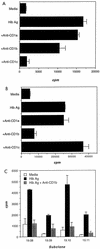CD1 presents antigens from a gram-negative bacterium, Haemophilus influenzae type B
- PMID: 9673229
- PMCID: PMC108382
- DOI: 10.1128/IAI.66.8.3523-3526.1998
CD1 presents antigens from a gram-negative bacterium, Haemophilus influenzae type B
Abstract
Human CD1 is a family of nonpolymorphic major histocompatibility complex class I-like molecules capable of presenting mycobacterial lipids, including lipoarabinomannan (LAM), to double-negative (DN; CD4(-) CD8(-)) as well as CD8(+) T cells. Structural similarities between LAM and the capsular polysaccharides of gram-negative bacteria led us to consider the latter as candidate CD1 ligands. We derived two CD1-restricted DN T-cell populations which proliferated to Haemophilus influenzae type b (Hib) antigen. One T-cell population also proliferated to proteinase K-treated Hib antigen, suggesting that it recognized a nonpeptide. Our work thus expands the universe of T cell antigens to include nonpeptides distinct from mycobacterial lipids and suggests a potential role for CD1-restricted T cells in immunity to Hib.
Figures



Similar articles
-
CD1--a new paradigm for antigen presentation and T cell activation.Clin Immunol Immunopathol. 1998 Apr;87(1):8-14. doi: 10.1006/clin.1997.4500. Clin Immunol Immunopathol. 1998. PMID: 9576005 Review.
-
Evidence for human CD4+ T cells in the CD1-restricted repertoire: derivation of mycobacteria-reactive T cells from leprosy lesions.J Immunol. 2000 May 1;164(9):4790-6. doi: 10.4049/jimmunol.164.9.4790. J Immunol. 2000. PMID: 10779786
-
Participation of CD1 molecules in the presentation of bacterial protein antigens in humans.Scand J Immunol. 1999 Oct;50(4):387-93. doi: 10.1046/j.1365-3083.1999.00607.x. Scand J Immunol. 1999. PMID: 10520178
-
Mechanisms of lipid antigen presentation by CD1.Crit Rev Immunol. 1999;19(1):49-63. Crit Rev Immunol. 1999. PMID: 9987600 Review.
-
Exogenous control of the expression of Group I CD1 molecules competent for presentation of microbial nonpeptide antigens to human T lymphocytes.Clin Dev Immunol. 2011;2011:790460. doi: 10.1155/2011/790460. Epub 2011 Mar 22. Clin Dev Immunol. 2011. PMID: 21603161 Free PMC article. Review.
Cited by
-
Antibody repertoires in infants and adults: effects of T-independent and T-dependent immunizations.Springer Semin Immunopathol. 2001 Dec;23(4):387-403. doi: 10.1007/s281-001-8166-x. Springer Semin Immunopathol. 2001. PMID: 11826616 Review.
-
CD40-CD40L independent Ig gene hypermutation suggests a second B cell diversification pathway in humans.Proc Natl Acad Sci U S A. 2001 Jan 30;98(3):1166-70. doi: 10.1073/pnas.98.3.1166. Proc Natl Acad Sci U S A. 2001. PMID: 11158612 Free PMC article.
-
Langerhans cells utilize CD1a and langerin to efficiently present nonpeptide antigens to T cells.J Clin Invest. 2004 Mar;113(5):701-8. doi: 10.1172/JCI19655. J Clin Invest. 2004. PMID: 14991068 Free PMC article.
References
-
- Beckman E M, Porcelli S A, Morita C T, Behar S M, Furlong S T, Brenner M B. Recognition of a lipid antigen by CD1-restricted alpha beta+ T cells. Nature. 1994;372:691–694. - PubMed
-
- Beckman E M, Brenner M B. MHC class I-like, class II-like and CD1 molecules: distinct roles in immunity. Immunol Today. 1995;16:349–352. - PubMed
Publication types
MeSH terms
Substances
Grants and funding
LinkOut - more resources
Full Text Sources
Research Materials

